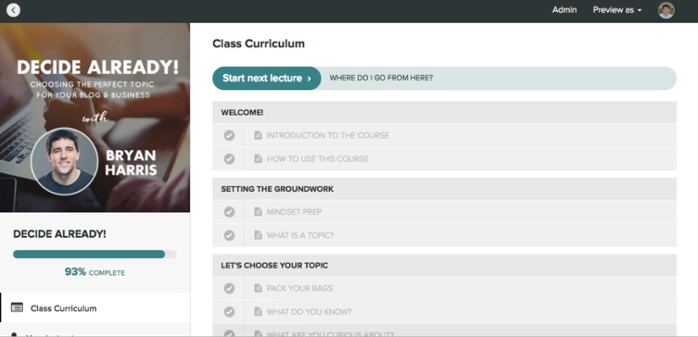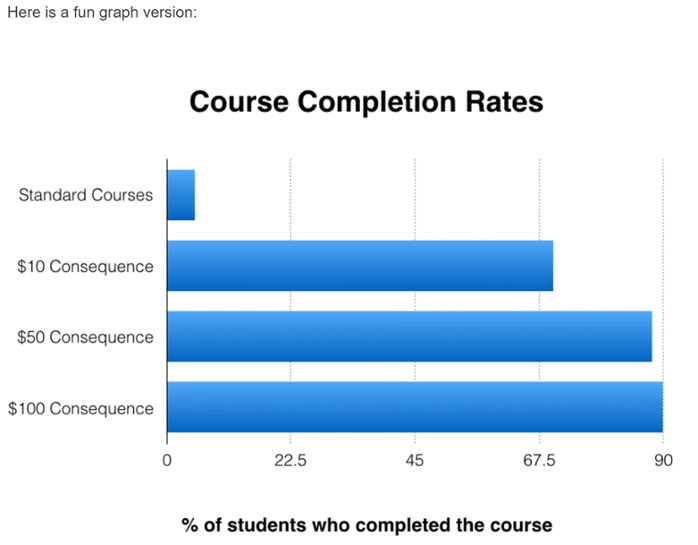[Case study] 15x your sales by optimizing for student success


It’s really incredible to think about all of the psychology-backed ways that you can make more money selling online courses. Things like closing your cart or having short-term coupons can cause a significant spike in sales, and clever email marketing can increase urgency in a real way. There are also less utilized methods of increasing revenue that are always fun to dive into.
Let’s talk about Bryan
One such example? Bryan Harris from Videofruit‘s consequence pricing strategy. Long story short, consequence pricing consists of adding a consequence via an extra charge to your online course for students who do not finish all lessons.
The thought behind this is that everyone wants to hang onto their money, so they’re going to be far more likely to finish your course if there is a consequence to not finishing the course.
In Bryan’s experiment he had three levels of consequences: $10, $50, or $100. And, no surprise, the larger the consequence the higher the completion rate of the course was and the more successful his students were in achieving their goals.
He got the metrics down
The relation between completion rates and student success is an important metric to monitor and optimize because if your students aren’t finishing your course they aren’t going to reach their intended results and that means they aren’t going to give you the word of mouth praise that you deserve.
But the fact of the matter is, students aren’t achieving their intended goals with the online courses they buy and that’s a real problem. In fact, across the industry it seems that completion rates are less than 20%.
What is your goal
Your goal is to have people take your online course and benefit from it. Not buy it and abandon it. People get busy and make excuses, and it’s easy for them to fall of the wagon but that’s where the instructor comes in. By implementing strategies that increase the completion rate and student success you’ll find yourself with more happy students who are more likely to share your course with the people in their network.


Bryan Harris of VideoFruit is a lifelong entrepreneur who is an expert at video and teaches others how to create and use videos in their online businesses. In addition to that, Bryan is a successful course creator who has learned a thing or two about optimizing for student success by increasing completion rates.
Not only that, but he found a way to make his students 15x more likely to buy his product.
How did he do that?
He combined two tactics:
-
Offering a free mini-course his audience could take before up selling them on their paid products.
-
Used consequence pricing to increase the percentage of students who succeeded at achieving the mini-course’s objective.
Bryan created a free mini-course called Decide Already! to serve as a funnel into his paid courses. Decide Already! was aimed at helping students pick a topic and niche for their online business idea.


Half the battle
Creating a free course on how to do this is just half of the work. Getting people to sign up is easy, but motivating them to go through the lessons and choose their topic and niche is where things got trickier.
It pays off
That’s where consequence pricing comes in.
When signing up for Decide Already! students needed to input their credit card details and choose a financial consequence should they not finish the course on time – to finish, students needed to submit your selected topic and niche.
Students could choose between consequences of $10, $50 and $100.
The results? Incredible.
Out of the 800+ people who took Bryan’s free course, 80% of them finished the course and successfully picked a topic and niche.


Pretty amazing on its own, but that’s not all.
Those successful students were 15X more likely to pay for the full course than those who did not take Decide Already! at all (and 6X more likely than those who didn’t finish it.)
Should you consider this as a pricing plan for your main course?
Short answer: no.
Bryan mentioned that he donated the profits from his experiment to charity. His objective wasn’t to make money out of it, but to give people the motivation to get to a desired outcome.
Ultimately, his free course served as a way to drive more traffic and convert more sales to his main product, of course, but consequence pricing was not as much a tactic to fill the top of the funnel, as it was a way of helping people go through the funnel.
Using this as a revenue source would be counter-productive as you would end up betting on your students to fail and that’s the opposite of what we’re trying to accomplish.
Completion rate vs. student success
An important thing to highlight here is that Bryan did not set up his consequence based pricing experiment up to merely increase completion rates for his course.
Course completion rate on its own is nothing more than a vanity metric: it makes you feel nice when it’s high, but not much else comes out of it. Yes, we want our students to finish our courses, but it’s more important to consider these factors:
-
Were your students pleased with the content?
-
Did they get all the information they needed?
-
Was there something else they would have liked to see in your course?
-
How can your course be better?
-
Would they recommend your course to other people?
The completion rate
A high completion rate could be deceiving and make you believe your course is doing great, in the same way a low completion rate might wrongly make you think your course is a failure.
Here are just a few reasons why experts believe completion rates are not enough to determine if an online course is good or not.
-
Justin Reich, a Harvard research fellow, suggests that the student’s initial intention to finish a course is are significantly more likely to complete it.
-
Jeff Seaman, co-director of the Babson Survey Research Group, said that completion rates are not as closely tied to the type format of education, as they are to the type of learners each format attracts. This makes sense right?
Everyone learns in different ways and just because someone doesn’t complete 100% of your course content doesn’t mean that they aren’t going to benefit from it.
Morgan’s thoughts
Here’s our writer Morgan Timm’s personal anecdote.
“Take me, for example. A little over a year ago I bought my first big online course (shout out to Melyssa Griffin’s Blog Hive!). The course focused on monetizing your blog through selling online courses and that’s the first time I ever heard of Teachable. Through a whirlwind of events, two months later I was on a plane moving to New York to intern with Teachable but in all of that chaos I never actually completed the course (whoops!).
With that said, I can tell you that purchasing that course was one of the best decisions I’ve made. And the content that I did get through taught me a lot about running an online business and gave me the knowledge I needed to start my job here without looking like a big, unknowledgable goofball. Whew, I might have just gotten a little sentimental there.”
The message
“But what I’m trying to say is that people don’t have to go through every single lesson and worksheet you have to offer for your course to change their lives. What matters more is what exactly they took from the content they did consume.
I’ll use myself as an example again. I’ve taken around two dozen more courses since the first and I have only completed a few. I usually am buying courses to improve on a skillset I already have and I find that some sections might be entirely irrelevant to me because I already feel comfortable with that area of the topic.
So I skip over those lessons entirely.
That might leave me with only completing 75% of the course I was taking, but I am still head over heels crazy about a few of those courses that are left a quarter unfinsihed and I’d recommend them to anyone who asks.”
Cultivate success
More than anything you want to make your students feel confident and successful and like they’ve learned something new or have improved in some way thanks to taking your course.
Bryan understands this and has made student success the number #1 priority for his company.
Bottom line is: While you read this post, keep in mind that completion rates indeed went up, but that’s because Bryan created a course in which that metric was very closely correlated to student success.
Understanding your students’ path to success
Not everyone is going to use your online offerings the way that you may have initially intended – but that’s not a bad thing.
Seeing how your students use and adapt your product so they can meet their own objectives is exciting and it introduces you to a new perspective.
However, this also poses a challenge for you as a course creator.
You will need to design a course that fits what most people want out of a topic and structure it in a way that matches their path to success.
This is where we think lies the brilliance of Bryan’s strategy.
Use milestones
He clearly identified three critical milestones in his student’s path to success.
-
Getting their first 100 subscribers
-
Reaching 1,000 subscribers
-
Launching a product and making money
By breaking the end goal into smaller (yet significant) wins, Bryan and his team can leverage these milestones as motivation boosters towards achieving the ultimate goal.
Keep achieving
Next, Bryan got even more granular, and identified the specific steps any student needed to take in order to achieve each milestone.
In the case of getting 100 subscribers, those are:
-
Deciding on their topic or niche
-
Getting their website set up
-
Getting 100 visitors to their website
-
Writing their first blog post
-
Selecting an email service provider
You can probably relate to this yourself.
Did you struggle figuring out a topic for your course? Or maybe you knew what you wanted to teach but didn’t know who to target?
When optimizing for success, Bryan looked into how to get more people to pick a topic and a niche.
Consequence pricing works
If you’re a regular on the Teachable Blog you all know and love Eduardo by now. When we were talking to Bryan about writing this post, he challenged Eduardo to a little experiment.
It’s one thing to look at this strategy and say it works, but they thought our argument would hold a little more weight if we tried it out for ourselves.
Bryan said he came up with this because he tried it on himself to lose weight and be healthier, so Eduardo followed in those footsteps and agreed to publicly keep track of every single one of his meals for a week.
Eduardo was far braver, and took the challenge head on and Bryan was able to check if he was logging his meals with $100 on the line.
Results
The results? Eduardo logged every single thing he ate for a week and knowing that big brother (or in this case, Bryan Harris) was watching, he claims he was even encouraged to eat a little bit healthier.
We have a free step-by-step roadmap to help you navigate your upcoming course launch. Get our “ultimate guide to course creation” today.
